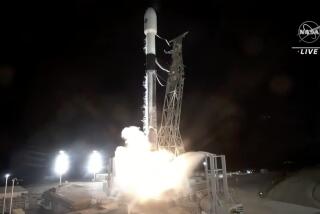Shoestring Space Race : Camarillo Firm Launches Plan for Cargo Rockets With Hope That the Potentially Profitable, but Risky, Venture Will Take Off
- Share via
George Koopman’s dream is embodied in a 6-foot-tall blueprint of a rocket that hangs on a wall at his American Rocket Co. in Camarillo. Above the blueprint, a sign reads: “Thank You for Not Laughing at This Vehicle.”
If all goes well, AMROC’s first rocket, all 58 feet and 32,000 pounds of it, will blast off from Vandenberg Air Force Base in July on a 15-minute suborbital flight. The unmanned rocket will hoist two paying cargoes and, according to plan, will splash down in the Pacific Ocean, 150 miles off the California coast. With an eye toward public relations, Koopman selected July 20 as the launch date--exactly 20 years after Neil Armstrong made his first small steps on the moon. The date, Koopman hopes, will become a giant step forward for AMROC in the privatization of space business.
There are half a dozen fledgling rocket companies like Koopman’s that hope to make a dollar by flying space cargoes, such as pharmaceutical or semiconductor experiments that use weightlessness to conduct tests, into low orbit.
Getting Off the Ground
In the aftermath of the Challenger space shuttle disaster in 1986, the private space industry is finally getting off the ground. The accident created a backlog of communications satellites and commercial experiments waiting to be launched, and the Europeans’ Ariane rockets have done a brisk trade launching them. The Chinese are getting into the business, as are some African nations. Since Congress and the Reagan Administration cleared the way for private U.S. space launchings, three big aerospace firms--McDonnell Douglas, Martin Marietta and General Dynamics--are reworking their trusted missile designs to carry private space cargo, including communications satellites.
A General Dynamics spokesman said tiny would-be rivals such as Koopman’s AMROC are not really a threat.
Koopman hints that he and his investors have put up $30 million to design, build and launch that rocket in July. He concedes that at the moment he has only enough money for one flight.
Dave Akin, assistant professor of aeronautics at MIT, helped to design an experimental capsule that AMROC will hoist into space. He said MIT is paying AMROC a token $1,000 to carry its package. Koopman said there is one other paying customer on the flight. He won’t say who, but the first flight isn’t intended to make a profit, he said, but to prove a point. “We started out believing nobody would pay us any money ‘til we’d done it,” he said.
Will Koopman’s rocket fly as planned? Akin laughs gently. Akin grew up within sight of Cape Canaveral. “I have seen lots of rockets blow up. Not to cast aspersions on American Rocket, but I think it would be unrealistic to expect this to work perfectly. They have as good as shot as anybody, but a rocket is a complex device.”
Akin said he is impressed with AMROC’s engine tests, but “pointing it where they want it to go,” is another worry. As standard procedure, an Air Force safety officer will watch the flight on a radar screen at Vandenberg. If the rocket takes a wrong turn for, say, Santa Barbara, the officer will push a button and blow up Koopman’s dream.
Koopman is hurrying to catch up to Space Services Inc., a Houston firm run by Deke Slayton, one of the original seven Mercury astronauts. Two months ago, Slayton’s company was the first U.S. firm under government license to successfully launch a private cargo rocket with 17 lab experiments from the University of Alabama on a 15-minute flight over New Mexico.
Slayton’s rocket is essentially a pastiche of proven missile parts bought from aerospace firms, while Koopman’s team is putting together its own fresh rocket design in hopes of lowering costs. “There’s a lot of risk associated with that kind of development,” Slayton said. “But, who knows, they may get lucky.”
Familiar With Risks
Koopman knows the risks. “A hundred things could go wrong,” he said, but he looks ahead.
In a few years, AMROC could be one of the few surviving start-up space companies, he said, with enough successful rocket launches that it could chase after the same satellite customers as the Big Three aerospace companies. It’ll be a $1-billion-a-year market, he said.
Koopman never worked for NASA, but that hasn’t slowed him down. An entrepreneur-turned-space enthusiast, in the 1970s he ran an Orange County company that made instructional films for the military and private industry. One film for Denny’s restaurants showed waiters how to sell a customer a piece of pie. Koopman also worked as a stunt director on “The Blues Brothers” film, helping to devise the final reel of dizzying car spills. One notable stunt involved a car that shot off a hill and crashed into the back of a speeding truck that kept hurtling down the highway. Koopman said the key to that stunt was “high school physics.”
His idea for AMROC is equally straightforward. As Federal Express did for small packages, Koopman hopes to do for 500- to 2,000-pound loads ticketed for space, using inexpensive but reliable rockets. His aim: Build rockets “like Toyota builds pickup trucks.”
Peter Glaser, a vice president at the Arthur D. Little think tank in Cambridge, Mass., said he admires Koopman’s efforts but noted that companies like AMROC have a tremendous handicap competing against aerospace giants whose rocket research is paid for by huge government purchases. But to persuade insurance companies to cover cargo of future AMROC customers, Glaser said, AMROC’s first flights must work as planned. “If they have a launch failure, that would be disastrous for them,” he said. “If it works successfully, he should have some interesting business potential.”
If it works .
If Koopman finishes his round of financing, he said, there will be cash to pay for a couple more flights. On the next suborbital flight in October, he said, the company has booked three paying customers that he declined to name. Next year, AMROC will begin orbital flights, he said, and, if all goes according to plan, his company will break even by the sixth flight.
To get AMROC started, Koopman put up $50,000 in May, 1985; since then he said he has invested about $500,000. After hiring some investment bankers--they “didn’t raise a nickel” Koopman said--he’s raised much more than $10 million, most of it from eight investors he won’t identify.
AMROC has about 100 employees and fills two buildings in a Camarillo industrial park. MIT’s Akin has toured the rocket factory. “It looks like an auto-body shop. And that’s good, because that’s the level of technology you need if you want to get costs down,” he said. The company tries to be cheap and innovative at once. One day last week, a worker was crawling inside a rocket fuselage, wearing yellow rubber dish gloves on his feet for better footing.
AMROC buys its major rocket parts custom-made by outside suppliers. The rocket exhaust, made of compression-molded fiberglass, is built by a Huntington Beach firm and costs $23,000 each. Ever parsimonious, Koopman noted that a lighter exhaust preferred by a big aerospace company would cost six times that sum.
Rocket Engine
The company’s most noteworthy design is its rocket engine. Rockets tend to have either solid or liquid fuel, but Koopman’s engineers decided that a hybrid system, using both types of fuel, would be less likely to explode. To test the engine, the company has spent upwards of $1 million, Koopman said, refurbishing abandoned missile launch pads and test sites at Edwards and Vandenburg Air Force bases.
Even if the rocket flies, is there enough business to keep the company going? Glaser said talk of a billion-dollar-a-year space market is premature. Much of the work done in space thus far, he said, is limited to laboratory research, and it will take time for a commercial market to develop.
Still, Koopman looks ahead to July. When will he know if his company will make it? “Approximately 80 seconds after the first vehicle lifts off the pad. It’s pretty fundamental.”
Boom or bust. Either way, Koopman and his investors figure to get a big bang for their buck.
More to Read
Inside the business of entertainment
The Wide Shot brings you news, analysis and insights on everything from streaming wars to production — and what it all means for the future.
You may occasionally receive promotional content from the Los Angeles Times.











